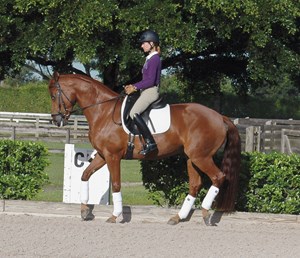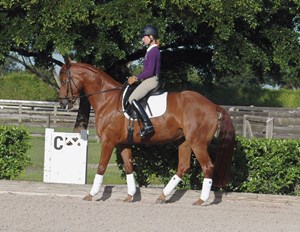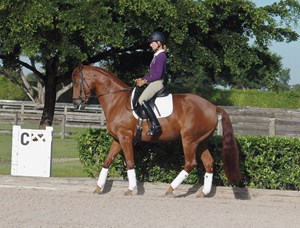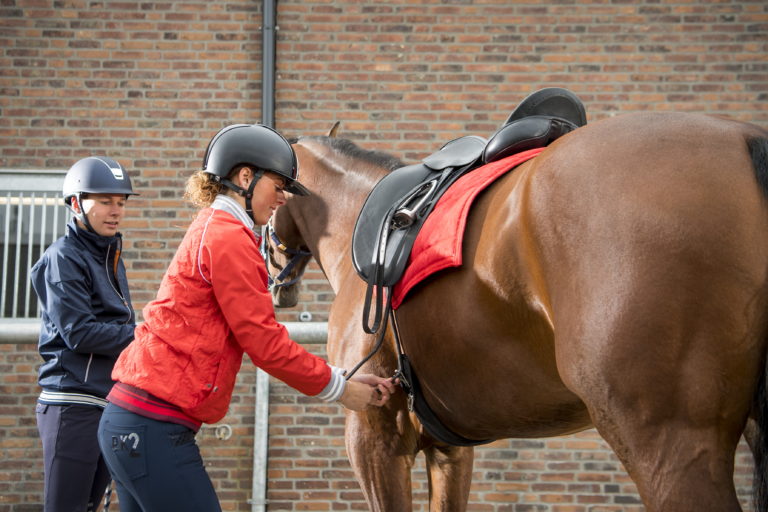The rein-back is a rearward movement in which the horse steps in diagonal pairs, or a two beat rhythm with no moment of suspension. In this movement, the horse should stay straight and on the bit. It is important to remember that the rein-back is always preceded by a halt, and that the halt must last three seconds prior to the horse moving backward. If the halt is not square, the first step of the rein-back may not be in diagonal pairs, so practice square, immobile halts.
The rein-back is a movement like the turn on the haunches and the walk pirouette in that it is considered a “nonbrilliance” movement. This means there is no score for the quality of the gaits (only the rhythm is important). So, these three movements can be ridden for a score of 10 by any type of horse with good training.
There was recently an interesting mathematical evaluation from the European company Global Dressage Analysis (GDA) in regard to the Olympics. The Dutch, Germans and British teams used this program prior to the 2012 Olympics. GDA’s thought was that if trainers and coaches had enough information about how a competing pair was scoring on each movement it could help improve their performance and hence their score.
For example, Horse A received scores of 6.5 or better 80 percent of the time in piaffe and passage work. But he only received a score of 5.5 75 percent of the time in the rein-back. The extensions were receiving scores of 7.5 or better 90 percent of the time. So where should the trainer and rider focus their training? On the rein backs, not on the extensions. I think this movement is too often ignored. Training it improves test scores. Check to see how many steps are required in your test.
History
The rein-back has been in tests from Second Level to Grand Prix for more than 30 years. It is a movement that improves the horse’s obedience to the aids, improves engagement and lightens the forehand. The FEI took the rein-back out of the Grand Prix test for a few years, but recently added a simple one back into the Grand Prix.
The old Grand Prix had a Schaukel, a movement in which there is a prescribed number of steps back, then a prescribed number of steps forward and then a prescribed number of steps back again prior to moving forward the fi nal time. This movement really helped sort out the class.
The score for your rein-back can be a double whammy in that it may also influence your submission score, as this exercise is a test of submission and not related to the gait score or the impulsion at all. The rein-back steps should be in diagonal pairs. In the Schaukel, the walk forward should be in a correct four-beat rhythm, while the rein-back is always in a two beat rhythm.
This exercise is used in all disciplines, not just dressage. In a trail horse class, you will see the horse being asked to back around a set of ground poles in the shape of an L. In reining, the rein-back is done after a sliding stop. Generally, in most flat classes—in hunter, Arabian, Western, etc.—horses are asked to back a few steps as the judge walks by the lineup. So never use the rein-back as a punishment because it makes a horse fear the exercise.
Judging the Rein-back
Judges must remember that the halt, the number of steps and the move off are modifiers to the score either up or down. The essence of this movement is the willingness of the horse to move backward in diagonal pairs.
The judge should be stricter at the highest levels and a bit more forgiving when the movement is new at Second Level. If you see a rider that uses incorrect aids for the rein-back and thus causes a low score, remember this when you give the Rider score in the Collective Marks for effect and correct influence of the rider.
If the horse is not willing to move backward or resists, comes off the bit etc., these issues can be reflected in the Submission score. Remember for a 10, the halt must be correct and maintained for three seconds. The horse must stay in self-carriage with the neck stretched up and out into the contact. The mouth should stay closed. The legs should lift and step back in equal steps (no toe dragging). The horse should then willingly walk or trot forward.
Here is a list of faults for judges to remember. I have listed them in the order where I think the top of the list is a more severe fault than those listed at the bottom:
• steps back not willing or resistant
• steps back not diagonal
• horse very crooked
• halt not shown
• horse drops contact
• horse runs backward
• horse gets slightly crooked
• number of steps not correct
• halt not square
• halt could be better maintained
A judge needs to think about the exercise being shown in this way: How difficult would the mistake shown be to correct? For me, if I think the training is going mostly in the correct way and there is a little mistake, I would be more forgiving. If I think it would take a lot of work to fix the training and the exercise, then I am stricter with my deductions.
Riding the Rein-back

The rein-back is always preceded by a halt in dressage. It is important to make sure your halt is well established and immobile. The rules now require the halt to last three seconds. For a rein-back that starts with the first step being clearly in diagonal pairs, the halt must be square.
When you train, be sure you have worked on your halts first—the horse must halt square and straight and stand with relaxation. Before you start the rein-back work, you may need to teach the horse to back from a voice command with you on the ground. Using your hand or the butt of the whip on the chest in a tapping motion along with the give and take on both reins with the command “back” will usually give the horse the right idea. When he is confident on the ground, then mount and give it a try. You may need a ground person for a few times.
Remember your aids must be very clear to the horse. Your halt should have your legs at the girth with a slight pressure and your seat firmly in the saddle. In preparation for the rein-back, move both legs slightly behind the girth and lighten your seat (“open the back door”). Squeeze softly with both legs into an elastic but firm connection (“closing the front door”). As soon as you feel the horse stretch to the bit and start to take a step back, relax your hand and leg aids.

Never teach the horse to run backward. Ask for one step at a time and give many rewards. Eventually, you can ask for the correct number of steps with the horse waiting for your aids.
Do rein-backs on the rail. If your horse has a tendency to get crooked, be sure your halt is in a bit of a shoulder fore position. To keep the horse straight, it is helpful to use a little bit of “indirect rein of opposition” with your inside rein moving a little toward your outside hip.
The willingness of the horse to move backward is important. As the rider, be sure to keep an elastic give and take on the reins so the horse can maintain the self-carriage and the good neck placement. Do not try to pull the horse backward. If during the movement, your horse starts to get stiff, don’t continue asking for the rein-back because any problems will only get worse. Better to have one less step back than to show major resistance in the movement.

The rein-back tells the judge a lot about the horse’s training. The rider should not waste the 10 points it can give you. Remember that this is a movement where any horse can get a 10, so make it is a highlight.
Janet Foy is an FEI 4* and USEF “S” and Sport Horse “R” breed judge. As a rider, she earned her USDF bronze, silver and gold medals. She is a member of the USEF International High Performance Dressage Committee and teaches judges’ training programs nationwide. The author of Dressage for the Not-So- Perfect Horse, she is based in Colorado Springs, Colorado.












